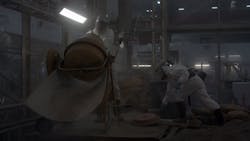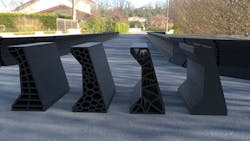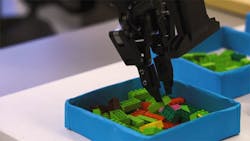Combining Tech to Colonize Mars and Redefine Manufacturing
We all know Elon Musk's true goal in life isn't to perfect automated manufacturing to churn out Tesla's electric cars. The ambitious futurist wants to get to Mars.
He detailed last September how that journey could start as early as 2022, with cargo shuttles dropping off power and mining equipment, while also verifying there's enough water to sustain a human settlement and act as a propellant for return trips to Earth. A few years later, a SpaceX BFR transport rocket would ferry space pilgrims to their new Plymouth (Red) Rock.
Lockheed Martin has similar plans with its Mars Base Camp. The massive space habitat would orbit Mars, with a surface lander dropping down for scientific missions. Lockheed theorizes the workup and validation would happen over the next decade
Today, Mars just so happens to be at the shortest distance from Earth, 35.8 million miles, since 2003. It's our closest planetary neighbor, but on average is still 140 million miles away. Each way would take nine months.
That's a long time between resupplies, so permanent structures will be needed to support a Martian colony. Even if the BFR drastically cuts the cost per pound to launch under $100, it's simply not practical to ship all the materials.
Fortunately, the materials may be already there. Despite having 1% of Earth's atmosphere, Mars' regolith layer, comprised of rocks, soil and dust, is similar to that found here. And NASA and Autodesk may have a way to convert this into building materials using advanced manufacturing techniques.
NASA's Swamp Works lab has combined hulking industrial robots with extruders similar to those used in 3D printers to fabricate building blocks from recycled plastic and this near-limitless supply of regolith. Autodesk used Fusion 360 engineering software and PowerMill machining software to control the robotic extruder, which created Jersey barriers.
"Additive manufacturing technology has the potential to revolutionize the way we do construction here on Earth, too," said Massimiliano Moruzzi of Autodesk's computational science research group. "If we can repurpose plastic pollution and use readily available natural resources to robotically print houses on Mars, we can use the same approach to sustainably build streets, sidewalks, and even playgrounds here at home."
Projects such as startup Apis Cor's 3d printed house and the Italian WASP (World's Advanced Saving Project) already indicate that combining additive technology and robotics works.
The NASA proof-of-concept's walls have geometrically sturdy lattice cores for optimized durability, while being hollow enough to make them lightweight. Each 3D-printed Jersey barrier is 145 lb.; 10-ft. concrete ones weighs two tons. Mars' gravity is 38% of Earth's, so a wall that normally weighs 200 lb. would become 76 lb.
That's important for two reasons. First, it means an Martian settler equipped with a powered exoskeleton like Sarcos' Guardian XO, which lifts 200 lb. "easily," could handle one of these on their own.
Onto the second and more likely scenario. A colony would be mostly built by robots prior to humans landing. They should ideally be lightweight, which means their payload, or lifting, capacity would be reduced. The UR10 weighs 63.7 lb. and has a payload capacity of 22 lb., which would increase to nearly 60 lb. on Mars.
In this scenario, another Autodesk project could come into play in a big way. Brickbot, created by Autodesk's AI team, is a Universal Robots' cobot with Robotiq parallel gripper, connected to sensors and cameras to create a neural network that could learn to manipulate Lego blocks the way a pre-schooler would.
The developers have taught Brickbot to sort through piles of various Legos to build little towers.
"By starting with plastic bricks, we've been able to keep the project manageable while still having the freedom to experiment from the design stage all the way to a finished product," said Yotto Koga, a project leader and software architect with a PhD in robotics. "Now we're close to taking the next step. We're planning to work closely with a manufacturing customer and a construction customer to see how the Brickbot technology can be applied in the real world."
As exciting as what it is to imagine how this could foster new life on Mars, the continued hybridization of emerging technology at home, and its potential to exponentially transform manufacturing processes, may be the most valuable lesson learned here.
"This is really the future of making things, says Fikret Kalay, an Autodesk technology consultant. "It's how we reimagine designing for manufacturing. So now we need to rethink how we design and manufacture parts by joining these two skills in one."
In addition, the factory might be the best place to focus for now because one big part of Musk's plan to colonize Mars was to nuke the poles to release CO2 into the atmosphere. Scientists say that if all the available CO2 on Mars was released, it would be only 7% of the Earth-like atmosphere.
About the Author
John Hitch
Editor, Fleet Maintenance
John Hitch, based out of Cleveland, Ohio, is the editor of Fleet Maintenance, a B2B magazine that addresses the service needs for all commercial vehicle makes and models (Classes 1-8), ranging from shop management strategies to the latest tools to enhance uptime.
He previously wrote about equipment and fleet operations and management for FleetOwner, and prior to that, manufacturing and advanced technology for IndustryWeek and New Equipment Digest. He is an award-winning journalist and former sonar technician aboard a nuclear-powered submarine where he served honorably aboard the fast-attack submarine USS Oklahoma City (SSN-723).







